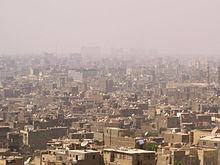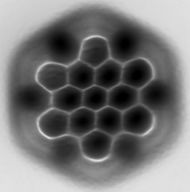Polycyclic aromatic hydrocarbon
A polycyclic aromatic hydrocarbon (PAH) is a class of
Polycyclic aromatic hydrocarbons are discussed as possible
Nomenclature and structure
The terms polyaromatic hydrocarbon,[3] or polynuclear aromatic hydrocarbon[4] (abbreviated as PNA) are also used for this concept.[5]
By definition, polycyclic aromatic hydrocarbons have multiple aromatic rings, precluding benzene from being considered a PAH. Some sources, such as the US EPA and CDC, consider naphthalene to be the simplest PAH.[6] Other authors consider PAHs to start with the tricyclic species phenanthrene and anthracene.[7] Most authors exclude compounds that include heteroatoms in the rings, or carry substituents.[8]
A polyaromatic hydrocarbon may have rings of various sizes, including some that are not aromatic. Those that have only six-membered rings are said to be alternant.[9]
The following are examples of PAHs that vary in the number and arrangement of their rings:
- Examples of polycyclic aromatic hydrocarbons
Geometry
Most PAHs, like naphthalene, anthracene, and coronene, are planar. This geometry is a consequence of the fact that the
In rare cases, PAHs are not planar. In some cases, the non-planarity may be forced by the
In theory, there are 51 structural isomers of coronene that have six fused benzene rings in a cyclic sequence, with two edge carbons shared between successive rings. All of them must be non-planar and have considerable higher bonding energy (computed to be at least 130 kcal/mol) than coronene; and, as of 2002, none of them had been synthesized.[11]
Other PAHs that might seem to be planar, considering only the carbon skeleton, may be distorted by repulsion or steric hindrance between the hydrogen atoms in their periphery. Benzo[c]phenantrene, with four rings fused in a "C" shape, has a slight helical distortion due to repulsion between the closest pair of hydrogen atoms in the two extremal rings.[12] This effect also causes distortion of picene.[13]
Adding another benzene ring to form dibenzo[c,g]phenantrene creates
Benzenoid hydrocarbons
The benzenoid hydrocarbons have been defined as condensed polycyclic unsaturated fully-conjugated hydrocarbons whose molecules are essentially planar with all rings six-membered. Full conjugation means that all carbon atoms and carbon-carbon bonds must have the sp2 structure of benzene. This class is largely a subset of the alternant PAHs, but is considered to include unstable or hypothetical compounds like triangulene or heptacene.[16]
As of 2012, over 300 benzenoid hydrocarbons had been isolated and characterized.[16]
Bonding and aromaticity
The
- Benzene-substructure resonance analysis for Clar's rule
-
Phenanthrene
-
Anthracene
-
Chrysene
For example,
Properties
Physicochemical
PAHs are
Redox
Polycyclic aromatic compounds characteristically yield
Half-cell potential of aromatic compounds against the SCE (Fc+/0)[24] Compound Potential (V) benzene −3.42 biphenyl[25] −2.60 (-3.18) naphthalene −2.51 (-3.1) anthracene −1.96 (-2.5) phenanthrene −2.46 perylene −1.67 (-2.2) pentacene −1.35
Sources
Artificial
The dominant sources of PAHs in the environment are thus from human activity: wood-burning and combustion of other
A year-long sampling campaign in Athens, Greece found a third (31%) of PAH urban air pollution to be caused by wood-burning, like diesel and oil (33%) and gasoline (29%). It also found that wood-burning is responsible for nearly half (43%) of annual PAH cancer-risk (carcinogenic potential) compared to the other sources and that wintertime PAH levels were 7 times higher than in other seasons, especially if atmospheric dispersion is low.[28][29]
Lower-temperature combustion, such as
PAHs are typically found as complex mixtures.[32][30]
Natural
Natural fires
PAHs may result from the incomplete combustion of organic matter in natural wildfires.[27][26] Substantially higher outdoor air, soil, and water concentrations of PAHs have been measured in Asia, Africa, and Latin America than in Europe, Australia, the U.S., and Canada.[26]
Fossil carbon
Polycyclic aromatic hydrocarbons are primarily found in natural sources such as bitumen.[33][34]
PAHs can also be produced geologically when organic sediments are chemically transformed into
Extraterrestrial
PAHs are prevalent in the interstellar medium (ISM) of galaxies in both the nearby and distant Universe and make up a dominant emission mechanism in the mid-infrared wavelength range, containing as much as 10% of the total integrated infrared luminosity of galaxies.[38] PAHs generally trace regions of cold molecular gas, which are optimum environments for the formation of stars.[38]
NASA's Spitzer Space Telescope and James Webb Space Telescope include instruments for obtaining both images and spectra of light emitted by PAHs associated with star formation. These images can trace the surface of star-forming clouds in our own galaxy or identify star forming galaxies in the distant universe.[39] In June 2013, PAHs were detected in the upper atmosphere of Titan, the largest moon of the planet Saturn.[40]
Minor sources
Certain PAHs such as perylene can also be generated in anaerobic sediments from existing organic material, although it remains undetermined whether abiotic or microbial processes drive their production.[41][42][43]
Distribution in the environment
Aquatic environments
Most PAHs are insoluble in water, which limits their mobility in the environment, although PAHs sorb to fine-grained organic-rich sediments.[44][45][46][47] Aqueous solubility of PAHs decreases approximately logarithmically as molecular mass increases.[48]
Two-ringed PAHs, and to a lesser extent three-ringed PAHs, dissolve in water, making them more available for biological uptake and
Human exposure
Human exposure varies across the globe and depends on factors such as smoking rates, fuel types in cooking, and pollution controls on power plants, industrial processes, and vehicles.[32][26][53] Developed countries with stricter air and water pollution controls, cleaner sources of cooking (i.e., gas and electricity vs. coal or biofuels), and prohibitions of public smoking tend to have lower levels of PAH exposure, while developing and undeveloped countries tend to have higher levels.[32][26][53] Surgical smoke plumes have been proven to contain PAHs in several independent research studies.[54]

Burning solid fuels such as
In industrial countries, people who smoke tobacco products, or who are exposed to second-hand smoke, are among the most highly exposed groups; tobacco smoke contributes to 90% of indoor PAH levels in the homes of smokers.[53] For the general population in developed countries, the diet is otherwise the dominant source of PAH exposure, particularly from smoking or grilling meat or consuming PAHs deposited on plant foods, especially broad-leafed vegetables, during growth.[56] Exposure also occurs through drinking alcohol aged in charred barrels, flavored with peat smoke, or made with roasted grains.[57] PAHs are typically at low concentrations in drinking water.[53]

Emissions from vehicles such as cars and trucks can be a substantial outdoor source of PAHs in particulate air pollution.[32][26] Geographically, major roadways are thus sources of PAHs, which may distribute in the atmosphere or deposit nearby.[58] Catalytic converters are estimated to reduce PAH emissions from gasoline-fired vehicles by 25-fold.[32]
People can also be occupationally exposed during work that involves fossil fuels or their derivatives, wood-burning,
Environmental pollution and degradation
PAHs typically disperse from
Two- and three-ringed PAHs can disperse widely while dissolved in water or as gases in the atmosphere, while PAHs with higher molecular weights can disperse locally or regionally adhered to particulate matter that is suspended in air or water until the particles land or settle out of the
PAHs transform slowly to a wide range of degradation products. Biological degradation by microbes is a dominant form of PAH transformation in the environment.[52][65] Soil-consuming invertebrates such as earthworms speed PAH degradation, either through direct metabolism or by improving the conditions for microbial transformations.[65] Abiotic degradation in the atmosphere and the top layers of surface waters can produce nitrogenated, halogenated, hydroxylated, and oxygenated PAHs; some of these compounds can be more toxic, water-soluble, and mobile than their parent PAHs.[62][66][67]
Urban soils
The British Geological Survey reported the amount and distribution of PAH compounds including parent and alkylated forms in urban soils at 76 locations in Greater London.[68] The study showed that parent (16 PAH) content ranged from 4 to 67 mg/kg (dry soil weight) and an average PAH concentration of 18 mg/kg (dry soil weight) whereas the total PAH content (33 PAH) ranged from 6 to 88 mg/kg and fluoranthene and pyrene were generally the most abundant PAHs.[68] Benzo[a]pyrene (BaP), the most toxic of the parent PAHs, is widely considered a key marker PAH for environmental assessments;[69] the normal background concentration of BaP in the London urban sites was 6.9 mg/kg (dry soil weight).[68] London soils contained more stable four- to six-ringed PAHs which were indicative of combustion and pyrolytic sources, such as coal and oil burning and traffic-sourced particulates. However, the overall distribution also suggested that the PAHs in London soils had undergone weathering and been modified by a variety of pre-and post-depositional processes such as volatilization and microbial biodegradation.
Peatlands
Managed
Rivers, estuarine and coastal sediments
Concentrations of PAHs in river and estuarine
Human health
Cancer is a primary human health risk of exposure to PAHs.[77] Exposure to PAHs has also been linked with cardiovascular disease and poor fetal development.
Cancer
PAHs have been linked to skin, lung, bladder, liver, and stomach cancers in well-established animal model studies.[77] Specific compounds classified by various agencies as possible or probable human carcinogens are identified in the section "Regulation and Oversight" below.
History

Historically, PAHs contributed substantially to our understanding of adverse health effects from exposures to environmental contaminants, including chemical carcinogenesis.[78] In 1775, Percivall Pott, a surgeon at St. Bartholomew's Hospital in London, observed that scrotal cancer was unusually common in chimney sweepers and proposed the cause as occupational exposure to soot.[79] A century later, Richard von Volkmann reported increased skin cancers in workers of the coal tar industry of Germany, and by the early 1900s increased rates of cancer from exposure to soot and coal tar was widely accepted. In 1915, Yamigawa and Ichicawa were the first to experimentally produce cancers, specifically of the skin, by topically applying coal tar to rabbit ears.[79]
In 1922,
In the 1930s and later, epidemiologists from Japan, the UK, and the US, including
Mechanisms of carcinogenesis

The structure of a PAH influences whether and how the individual compound is carcinogenic.[77][81] Some carcinogenic PAHs are genotoxic and induce mutations that initiate cancer; others are not genotoxic and instead affect cancer promotion or progression.[81][82]
PAHs that affect
Enzymes in the cytochrome family (CYP1A1, CYP1A2, CYP1B1) metabolize PAHs to diol epoxides.[87] PAH exposure can increase production of the cytochrome enzymes, allowing the enzymes to convert PAHs into mutagenic diol epoxides at greater rates.[87] In this pathway, PAH molecules bind to the aryl hydrocarbon receptor (AhR) and activate it as a transcription factor that increases production of the cytochrome enzymes. The activity of these enzymes may at times conversely protect against PAH toxicity, which is not yet well understood.[87]
Low molecular weight PAHs, with two to four aromatic hydrocarbon rings, are more potent as co-carcinogens during the promotional stage of cancer. In this stage, an initiated cell (a cell that has retained a carcinogenic mutation in a key gene related to cell replication) is removed from growth-suppressing signals from its neighboring cells and begins to clonally replicate.[88] Low-molecular-weight PAHs that have bay or bay-like regions can dysregulate gap junction channels, interfering with intercellular communication, and also affect mitogen-activated protein kinases that activate transcription factors involved in cell proliferation.[88] Closure of gap junction protein channels is a normal precursor to cell division. Excessive closure of these channels after exposure to PAHs results in removing a cell from the normal growth-regulating signals imposed by its local community of cells, thus allowing initiated cancerous cells to replicate. These PAHs do not need to be enzymatically metabolized first. Low molecular weight PAHs are prevalent in the environment, thus posing a significant risk to human health at the promotional phases of cancer.
Cardiovascular disease
Adult exposure to PAHs has been linked to cardiovascular disease.[89] PAHs are among the complex suite of contaminants in tobacco smoke and particulate air pollution and may contribute to cardiovascular disease resulting from such exposures.[90]
In laboratory experiments, animals exposed to certain PAHs have shown increased development of plaques (
Oxidative stress following PAH exposure could also result in cardiovascular disease by causing inflammation, which has been recognized as an important factor in the development of atherosclerosis and cardiovascular disease.[92][93] Biomarkers of exposure to PAHs in humans have been associated with inflammatory biomarkers that are recognized as important predictors of cardiovascular disease, suggesting that oxidative stress resulting from exposure to PAHs may be a mechanism of cardiovascular disease in humans.[94]
Developmental impacts
Multiple
Regulation and oversight
Some governmental bodies, including the
Priority polycyclic aromatic hydrocarbons identified by the US EPA, the US Agency for Toxic Substances and Disease Registry (ATSDR), and the European Food Safety Authority (EFSA) due to their carcinogenicity or genotoxicity and/or ability to be monitored are the following:[101][102][103]
|
|
- A Considered probable or possible human carcinogens by the US EPA, the European Union, and/or the International Agency for Research on Cancer (IARC).[103][5]
Detection and optical properties
A spectral database exists
PAHs possess very characteristic
Origins of life
(Spitzer Space Telescope
PAHs may be abundant in the universe.[2][106][107][108] They seem to have been formed as early as a couple of billion years after the Big Bang, and are associated with new stars and exoplanets.[1] More than 20% of the carbon in the universe may be associated with PAHs.[1] PAHs are considered possible starting material for the earliest forms of life.[1][2] Light emitted by the

PAHs, subjected to interstellar medium (ISM) conditions, are transformed, through hydrogenation, oxygenation, and hydroxylation, to more complex organic compounds—"a step along the path toward amino acids and nucleotides, the raw materials of proteins and DNA, respectively".[112][113] Further, as a result of these transformations, the PAHs lose their spectroscopic signature which could be one of the reasons "for the lack of PAH detection in interstellar ice grains, particularly the outer regions of cold, dense clouds or the upper molecular layers of protoplanetary disks."[112][113]
Low-temperature chemical pathways from simple organic compounds to complex PAHs are of interest. Such chemical pathways may help explain the presence of PAHs in the low-temperature atmosphere of Saturn's moon Titan, and may be significant pathways, in terms of the PAH world hypothesis, in producing precursors to biochemicals related to life as we know it.[114][115]
See also
References
- ^ a b c d e Hoover, R. (2014-02-21). "Need to Track Organic Nano-Particles Across the Universe? NASA's Got an App for That". NASA. Retrieved 2014-02-22.
- ^ a b c Allamandola, Louis; et al. (2011-04-13). "Cosmic Distribution of Chemical Complexity". NASA. Archived from the original on 2014-02-27. Retrieved 2014-03-03.
- ^ a b Gehle, Kim. "Toxicity of Polycyclic Aromatic Hydrocarbons (PAHs): Health Effects Associated With PAH Exposure". CDC. Agency for Toxic Substances and Disease Registry. Archived from the original on 6 August 2019. Retrieved 2016-02-01.
- ^ "Polycyclic Aromatic Hydrocarbons (PAHs)" (PDF).
Naphthalene is a PAH that is produced commercially in the US
- ^ G.P. Moss IUPAC nomenclature for fused-ring systems[full citation needed]
- S2CID 97930473.
- ISBN 978-3-540-49697-7.
- ^ a b Takuya Echigo, Mitsuyoshi Kimata, and Teruyuki Maruoka (2007): "Crystal-chemical and carbon-isotopic characteristics of karpatite (C24H12) from the Picacho Peak Area, San Benito County, California: Evidences for the hydrothermal formation". American Mineralogist, volume 92, issues 8-9, pages 1262–1269.
- ^ ISBN 9783642871436
- LCCN 63012392.
- doi:10.1002/poc.938.
- PMID 21656594.
- .
- S2CID 98098882.
- ^ "Addendum to Vol. 2. Health criteria and other supporting information", Guidelines for drinking-water quality (2nd ed.), Geneva: World Health Organization, 1998
- .
- .
- .
- ^ ISBN 978-1-4398-3831-0.
- ^ .
- ^ "Wood burners cause nearly half of urban air pollution cancer risk – study". The Guardian. 17 December 2021. Retrieved 16 January 2022.
- S2CID 245103794.
- ^ PMID 22243855.
- ISSN 1309-1042.
- ^ S2CID 2388197.
- ISBN 978-3527306732.
- ^ "QRPOIL". www.qrpoil.com. Archived from the original on 2016-03-04. Retrieved 2018-07-19.
- ^ a b Svea Hernandez: Shining Light on the CO-dark Molecular Gas in the Heart of M83, retrieved 2022-01-09
- ^ Robert Hurt (2005-06-27). "Understanding Polycyclic Aromatic Hydrocarbons". Spitzer Space Telescope. Retrieved 2018-04-21.
- ^ López Puertas, Manuel (2013-06-06). "PAHs in Titan's Upper Atmosphere". CSIC. Archived from the original on 2013-12-03. Retrieved 2013-06-06.
- S2CID 36874753.
- ISSN 0009-2541.
- .
- S2CID 25505589.
- PMID 23820194.
- .
- ^ a b c Choi, H.; Harrison, R.; Komulainen, H.; Delgado Saborit, J. (2010). "Polycyclic aromatic hydrocarbons". WHO Guidelines for Indoor Air Quality: Selected Pollutants. Geneva: World Health Organization.
- ^ PMID 15327858.
- ISBN 978-3-642-08286-3.
- PMID 7821285.
- PMID 29033701.
- ^ PMID 19442441.
- ^ a b c d Choi, H.; Harrison, R.; Komulainen, H.; Delgado Saborit, J. (2010). "Polycyclic aromatic hydrocarbons". WHO Guidelines for Indoor Air Quality: Selected Pollutants. Geneva: World Health Organization.
- PMID 24715421.
- PMID 21705140.
- PMID 10415437.
- PMID 38241190.
- ^ PMID 29033701.
- ^ S2CID 35174373.
- ^ S2CID 25991349. Retrieved 2015-04-13.
- ^ PMID 31325853.
- ^ S2CID 23704718.
- PMID 19195680.
- S2CID 6404851.
- ^ PMID 15327858.
- S2CID 36295655.
- S2CID 205722865.
- ^ ISSN 0883-2927.
- PMID 20201516.
- ^ PMID 23416203.
- PMID 18715597.
- ^ S2CID 1480181.
- ISSN 1755-6910.
- S2CID 19881327.
- ^ PMID 17258286.
- PMID 18990413.
- ^ PMID 12060843.
- PMID 18757397.
- ^ ISBN 978-0-8412-0924-4.
- ^ International Agency for Research on Cancer (1984). Polynuclear Aromatic Compounds, Part 3, Industrial Exposures in Aluminium Production, Coal Gasification, Coke Production, and Iron and Steel Founding (Report). IARC Monographs on the Evaluation of Carcinogenic Risks to Humans. Lyon, France: World Health Organization. pp. 89–92, 118–124. Archived from the original on April 7, 2010. Retrieved 2016-02-13.
- ^ S2CID 4847912.
- PMID 6385617.
- ^ PMID 15963346.
- S2CID 26021902.
- PMID 19531241.
- ^ PMID 22945568.
- ^ PMID 15028720.
- ^ S2CID 41215420.
- S2CID 30406435.
- ^ PMID 17951105.
- ^ S2CID 25713047.
- S2CID 28408634. Archived from the original(PDF) on 2016-10-09. Retrieved 2015-12-16.
- PMID 19095723.
- S2CID 44543315.
- PMID 15811825.
- PMID 20851760.
- PMID 15126074.
- PMID 26241071.
- ^ PMID 24013021.
- ^ European Union (2013-12-06), Commission Regulation (EU) 1272/2013, retrieved 2016-02-01
- S2CID 98493548.
- ^ Agency for Toxic Substances and Disease Registry (ATSDR) (1995). Toxicological profile for Polycyclic Aromatic Hydrocarbons (PAHs) (Report). Atlanta, GA: U.S. Department of Health and Human Services, Public Health Service. Retrieved 2015-05-06.
- ^ a b EFSA Panel on Contaminants in the Food Chain (CONTAM) (2008). Polycyclic Aromatic Hydrocarbons in Food: Scientific Opinion of the Panel on Contaminants in the Food Chain (Report). Parma, Italy: European Food Safety Authority (EFSA). pp. 1–4.
- ^ "NASA Ames PAH IR Spectroscopic Database". www.astrochem.org.
- S2CID 51920955.
- ^ Carey, Bjorn (2005-10-18). "Life's Building Blocks 'Abundant in Space'". Space.com. Retrieved 2014-03-03.
- S2CID 7808613.
- ^ Clavin, Whitney (2015-02-10). "Why Comets Are Like Deep Fried Ice Cream". NASA. Retrieved 2015-02-10.
- ^ a b Battersby, S. (2004). "Space molecules point to organic origins". New Scientist. Retrieved 2009-12-11.
- ^ S2CID 14545794.
- ^ Staff (2010-07-28). "Bright Lights, Green City". NASA. Retrieved 2014-06-13.
- ^ a b Staff (2012-09-20). "NASA Cooks Up Icy Organics to Mimic Life's Origins". Space.com. Retrieved 2012-09-22.
- ^ S2CID 5541727.
- ^ ""A Prebiotic Earth" – Missing Link Found on Saturn's Moon Titan". DailyGalaxy.com. 11 October 2018. Archived from the original on 14 Aug 2021. Retrieved 11 October 2018.
- S2CID 105480354.
External links
- ATSDR - Toxicity of Polycyclic Aromatic Hydrocarbons (PAHs) U.S. Department of Health and Human Services
- Fused Ring and Bridged Fused Ring Nomenclature
- Database of PAH structures
- Cagliari PAH Theoretical Database
- NASA Ames PAH IR Spectroscopic Database
- National Pollutant Inventory: Polycyclic Aromatic Hydrocarbon Fact Sheet
- Understanding Polycyclic Aromatic Hydrocarbons NASA Spitzer Space Telescope
- "The Aromatic World: An Interview with Professor Pascale Ehrenfreund" from Astrobiology Magazine
- Oregon State University Superfund Research Center focused on new technologies and emerging health risks of Polycyclic Aromatic Hydrocarbons (PAHs)
- Polycyclic Aromatic Hydrocarbons (PAHs)--EPA Fact Sheet. U.S. Environmental Protection Agency, Office of Solid Waste, January 2008.













![Benzo[a]pyrene](http://upload.wikimedia.org/wikipedia/commons/thumb/f/fa/Benzo-a-pyrene.svg/120px-Benzo-a-pyrene.svg.png)

![Benzo[ghi]perylene](http://upload.wikimedia.org/wikipedia/commons/thumb/f/ff/Benzo%28ghi%29perilene.png/120px-Benzo%28ghi%29perilene.png)


![Benzo[c]fluorene](http://upload.wikimedia.org/wikipedia/commons/thumb/4/4f/Benzocfluorene.svg/120px-Benzocfluorene.svg.png)

